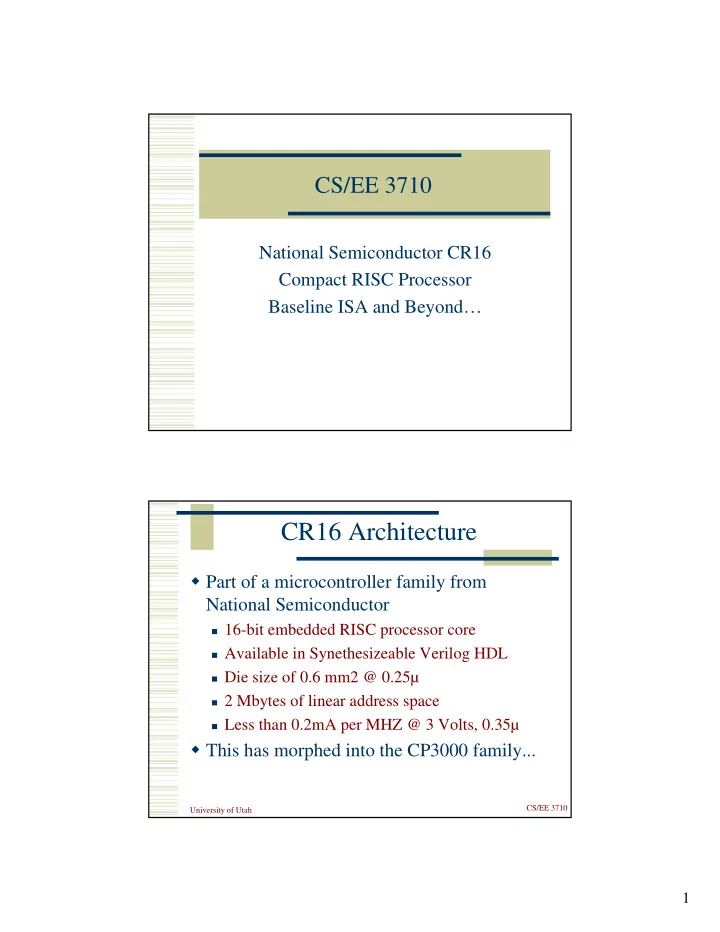

CS/EE 3710 National Semiconductor CR16 Compact RISC Processor Baseline ISA and Beyond… CR16 Architecture � Part of a microcontroller family from National Semiconductor � 16-bit embedded RISC processor core � Available in Synethesizeable Verilog HDL � Die size of 0.6 mm2 @ 0.25µ � 2 Mbytes of linear address space � Less than 0.2mA per MHZ @ 3 Volts, 0.35µ � This has morphed into the CP3000 family... CS/EE 3710 University of Utah 1
CR16 Architecture � More specs… � Static 0 to 66 MHz clock frequency � Atomic memory-direct bit manipulation instructions � Save and Restore of Multiple Registers � Push and Pop of Multiple Registers � Hardware Multiplier Unit for fast 16-bit multiplication CS/EE 3710 University of Utah CR16 Block Diagram CS/EE 3710 University of Utah 2
CR16 Register Set � All registers are 16 bits wide � Except address registers which are 21 bits � Original version used 18 bits… � 16 general purpose registers � 8 processor registers � 3 dedicated address registers (PC, ISP, INTBASE) � 1 Processor Status Register � 1 configutation register � 3 debug-control registers CS/EE 3710 University of Utah CR16 Registers CS/EE 3710 University of Utah 3
Processor Registers � PSR – Processor Status Register � C, T, L, F, Z, N, E, P, I bits � Carries, conditions, interrupt enables, etc. � INTBASE - Interrupt Base register � Holds the address of the dispatch table for interrupts and traps � ISP – Interrupt Stack Pointer � Points to the lowest address of the last item stored on the interrupt stack CS/EE 3710 University of Utah CR16 Instruction Encoding � More complex than our version… CS/EE 3710 University of Utah 4
CR16 Instructions � Most ALU instructions have two forms � MOVi -> MOVW or MOVB � Two-address instruction formal � One of the two arguments is also used as destination (Rdest) and is overwritten � ADD R0, R3 => R3 := R0 + R3 � Little-Endian data references � Least-significant is lowest numbered � Both bits and bytes CS/EE 3710 University of Utah CR16 Instructions CS/EE 3710 University of Utah 5
More CR16 Instructions CS/EE 3710 University of Utah Even More CR16 Instructions CS/EE 3710 University of Utah 6
Still More CR16 Instructions CS/EE 3710 University of Utah More and More Instructions CS/EE 3710 University of Utah 7
CR16 Memory Map CS/EE 3710 University of Utah CR16 Exceptions � Interrupt � Exception caused by external activity � CR16 recognizes three types, Maskable, Non-maskable, and ISE (In-System Emulator) � Trap � Exception caused by program action � Six types: SVC, DVZ, FLG, BPT, TRC, UND � Interrupt process saves PC and PSR on interrupt stack, RETX returns from interrupt CS/EE 3710 University of Utah 8
CR16 Pipeline � Three stage pipe � Fetch � Decode � Execute � Instruction execution is serialized after an exception � Also serialized after LPR, RETX, and EXCP CS/EE 3710 University of Utah Our Class Version! � Baseline instruction set uses (almost) fixed instruction encoding � Detailed description on the web page � All instructions are a single 16-bit word � All memory references (inst or data) operate on 16-bit words � Not all instructions are included � Each group will extend the baseline ISA somehow CS/EE 3710 University of Utah 9
Baseline ISA � ADD, ADDI, SUB, SUBI � CMP, CMPI � AND, ANDI, OR, ORI, XOR, XORI � MOV, MOVI � LSH, LSHI (restricted to shift of one) � LUI, LOAD, STOR � Bcond, Jcond, JAL CS/EE 3710 University of Utah Class Encoding � In the handout on the web � Much more regular than real CR16 CS/EE 3710 University of Utah 10
Data Types � All data is 16-bit � Two’s complement encoding for data � Unsigned for address manipulation � Boolean for boolean operations � Of course, the ALU doesn’t know which is which – they’re all 16bit clumps to the ALU! � Flags are set for all interpretations � The programmer can sort out the flags later CS/EE 3710 University of Utah PSR Issues � Only ADD, ADDI, SUB, SUBI, CMP, CMPI can change the PSR flags � CMP, CMPI are the same as SUB, SUBI � But, they affect the PSR differently � Only PSR bits FLCNZ are needed for baseline implementation � ADD, ADDI, SUB, SUBI set the C on carry out and F on overflow � CMP, CMPI set Z, L (unsigned), and N (signed) CS/EE 3710 University of Utah 11
Conditional Jumps/Branches � Jumps are absolute � Branches are relative to current PC � JAL Jump and Link stores the address of the next instruction in Rlink, and jumps to Rtarget � Return with JUC Rlink � Conditions are derived from PSR bits CS/EE 3710 University of Utah Condition Table CS/EE 3710 University of Utah 12
Memory Map � 16 bit PC and LOAD/STOR addresses � 64k addresses � Each address is a 16-bit word � So, 128k bytes of data, but organized as words � But, only 40k bytes of block RAM on Spartan-3E � But, 64M bytes of SDRAM � But, SRDAM is a pain... � We need to reserve some I/O addresses � Up to you, but I recommend using the some top address bits � Upper 16k words (32kbytes) as I/O space? CS/EE 3710 University of Utah Memory Map 0000 16k words Word Code/Data 32k bytes addresses 3FFF 4000 Code/Data 7FFF Top two address 8000 bits define regions Code/Data BFFF C000 I/O Interrupt dispatch Switches/LEDs tables? UART FFFF CS/EE 3710 University of Utah 13
Recommend
More recommend